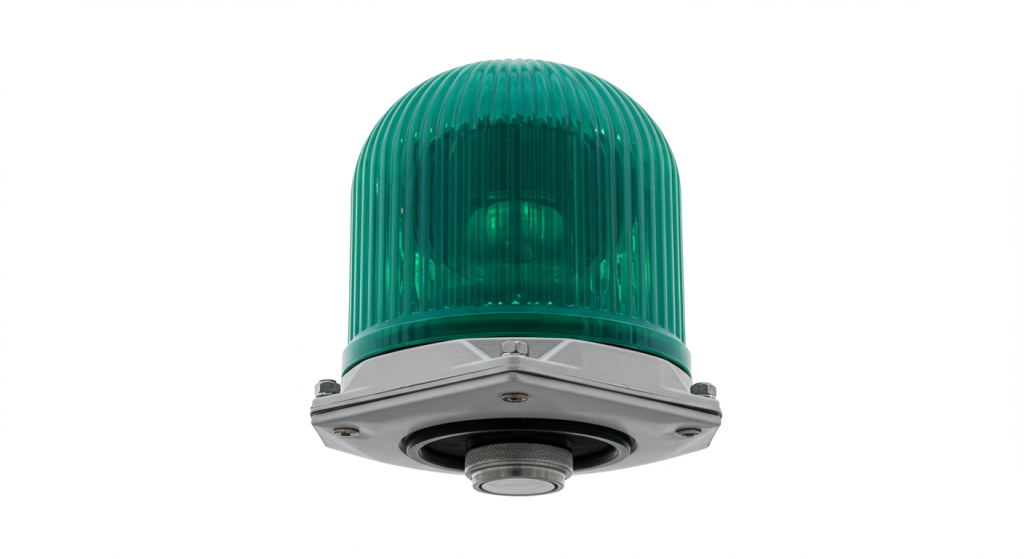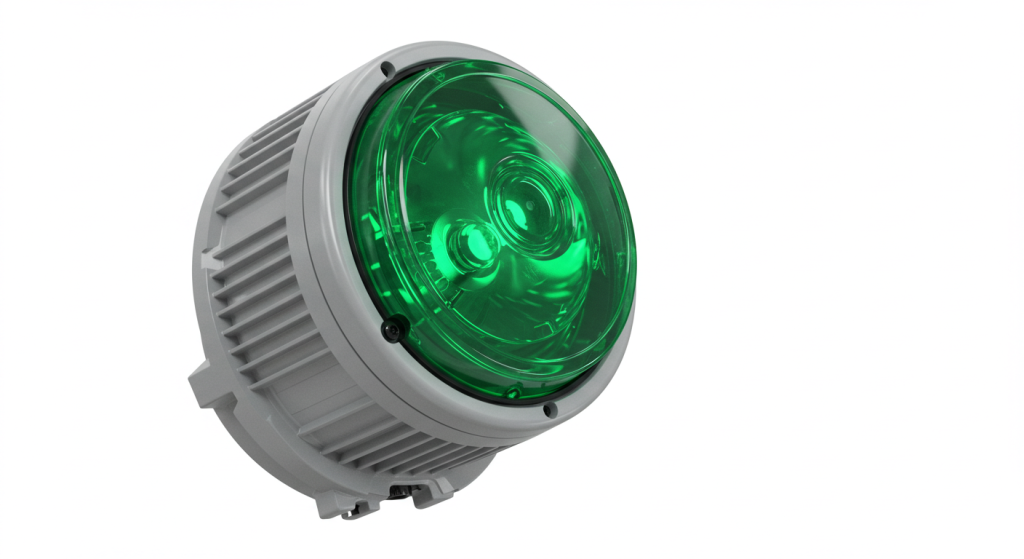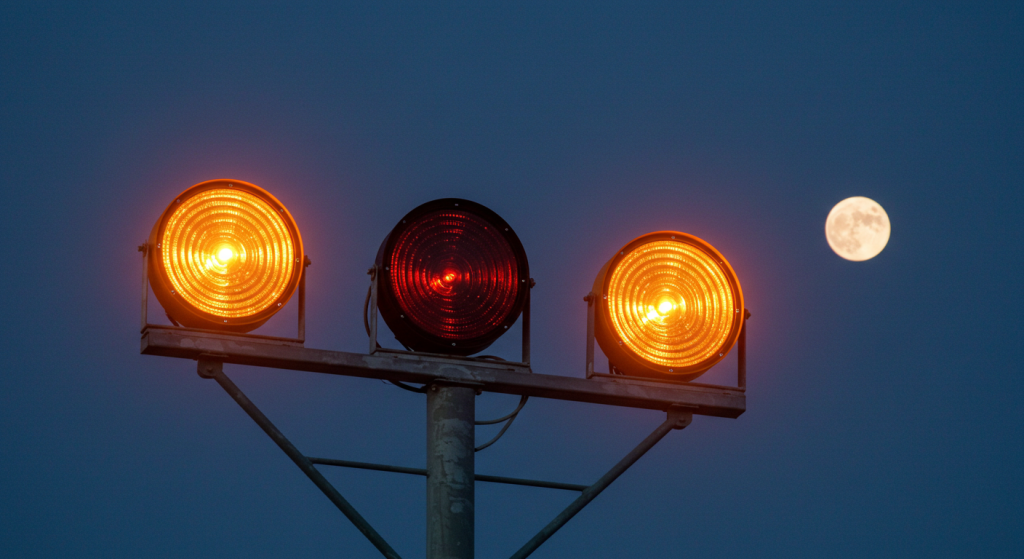Between the skyscrapers of bustling cities and the chimneys and iron towers of vast lands, there is a special type of lighting fixture – aviation obstruction lights. They are like “eyes” in the night sky, flashing continuously 24 hours a day, silently escorting low altitude flight safety. Although these lamps may seem ordinary, they contain advanced design and significant mission, building a tight low altitude protective net for the aviation industry.

Types and Features of Aviation Obstruction Lights
Aviation obstacle lights are mainly divided into two types based on the color of light emission: red and white. Red obstacle lights are often used for warning of obstacles at low to medium heights, such as ordinary buildings, communication towers, etc. It has a longer wavelength and strong penetration under complex weather conditions such as fog and dust, allowing pilots to clearly identify obstacles at a longer distance. White obstacle lights are usually installed at higher positions such as the tops of super tall buildings and large bridges, with higher brightness and wider visibility, like bright lighthouses in the night sky, ensuring that aircraft can avoid tall obstacles in advance during takeoff and landing or high-altitude cruising.
The red aviation obstruction lights
Red aviation obstruction lights typically have a constant illumination or specific flashing pattern. They emit signals with red light, which is better detected by pilots at night and in adverse weather conditions. Especially during low altitude flight, red lights provide clear visual warnings for pilots, helping to avoid collisions with obstacles.

From the perspective of light intensity, red aviation obstruction lights usually belong to low or medium light intensity types. The characteristic of low light intensity red aviation obstacle lights is that their peak light intensity is greater than 32.5cd. They are generally not used alone, but are used in conjunction with medium and high light intensity obstacle lights to provide auxiliary warning for obstacles at lower heights. For example, low intensity red aviation obstruction lights can be seen on structures such as iron towers, chimneys, high-rise buildings, and large bridges.
The use of red aviation obstruction lights is very widespread. They are usually installed on top of high-rise buildings, chimneys, bridges, and other tall structures, as well as in areas that require special labeling. If these obstacles are not properly marked, they may pose a collision risk to low flying aircraft. Therefore, the presence of red aviation obstruction lights is of great significance for ensuring flight safety.
The white aviation obstruction lights
Firstly, white aviation obstruction lights are characterized by their prominent white glow, which makes them particularly eye-catching at night or in low visibility conditions, helping pilots identify and avoid obstacles from a distance.
In terms of luminous intensity, white aviation obstruction lights usually have higher light intensity, especially high-intensity aviation obstruction lights A and B. Their effective light intensity varies during the day, dusk, dawn, and night to adapt to different lighting conditions at different times. For example, the effective light intensity of high-intensity A-type lamps during the day can reach 200000 cd ± 25%, ensuring clear visibility even in strong daylight.
Regarding the flashing mode, white aviation obstruction lights often use flashing mode instead of constant light. This flashing mode not only saves energy, but also effectively attracts the pilot’s attention. The flashing frequency is usually not less than 20 times per minute and not more than 60 times per minute, which not only avoids visual fatigue caused by excessive frequency, but also ensures that pilots have enough time to react.
Finally, in terms of application scenarios, white aviation obstacle lights are mainly used on the top or key parts of tall obstacles such as high-rise buildings, large bridges, and power line towers. These obstacles, due to their significant height, pose a potential threat to low flying aircraft, and therefore require the installation of white aviation obstacle lights to provide clear visual warnings. Especially on high-rise buildings in cities, the installation of white aviation obstruction lights is particularly important to ensure flight safety.

From the perspective of flashing frequency, aviation obstacle lights are divided into various modes such as constant light, low light intensity flashing, medium light intensity flashing, and high light intensity flashing. The constant light type provides continuous and stable lighting, suitable for areas with low ambient light, relatively low obstacles, and less busy surrounding airspace; Low intensity flashes softly at longer intervals, which not only saves energy but also meets general warning needs; The flashing rhythm of medium intensity flashes is accelerated, and the level of visibility is significantly increased, making it suitable for areas with high obstacles or high warning requirements; High intensity flashes are the most dazzling, often used around busy airports and obstacles along important routes. They flash frequently at extremely short intervals, allowing pilots to instantly capture targets even in strong background light.
In addition, different types of obstacle lights are arranged in layers based on the height of obstacles. For example, buildings with a height between 45 meters and 105 meters will have medium intensity B-type obstacle lights installed on their tops, flashing at a specific rhythm; Obstacles exceeding 105 meters in height require the installation of high-intensity A-type lights, whose powerful beams can penetrate high-altitude clouds and ensure unobstructed flight paths. This method of finely configuring the lighting system based on high precision creates a three-dimensional warning architecture that covers various low altitude flight scenes in all directions.
Core Technology Analysis
The light source is the heart of aviation obstruction lights. In the early days, halogen tungsten lamps were often used, which relied on the filament to generate heat and emit light. Although the color rendering is still acceptable, the lifespan is short and the energy consumption is high. Frequent replacement of bulbs increases maintenance costs and safety risks. With the development of technology, LED (Light Emitting Diode) light sources have emerged as a new force. LED has high light efficiency, and the conversion efficiency of electrical energy into light energy far exceeds that of traditional light sources, significantly reducing energy consumption; Ultra long lifespan, often tens of thousands of hours, reducing the frequency of maintenance for high-altitude operations; And with fast response speed, it can accurately achieve complex flashing patterns, instantly light up and turn off, allowing for precise transmission of warning signals. Combined with precision optical lenses, LED light sources can focus and scatter light into beam angles that meet aviation standards, enhancing long-range visibility.
The intelligent control module endows the obstacle lights with a “smart brain”. It is equipped with a precision clock chip that follows the standard procedures of the International Civil Aviation Organization (ICAO) to accurately control the day night switching and flashing frequency of lights. When there is sufficient sunlight during the day, the light sensing element is activated, automatically reducing the brightness of the light or stopping flashing to enter standby mode, saving energy and reducing consumption; As night falls and the light weakens, the control module wakes up the lighting fixtures, switches to night mode, increases brightness as needed, and starts flashing. Some high-end products are also equipped with wireless communication modules to achieve remote monitoring. Maintenance personnel can real-time grasp the operation status, battery level, and fault information of the lamps, adjust parameters or start self check repair programs through remote commands, greatly improving maintenance efficiency and ensuring that the lamps are always on standby.
The shell of aviation obstruction light is also a key link, facing high altitude strong wind, rainstorm, sand and dust, and ultraviolet radiation. The high-quality shell is made of high-strength aluminum alloy or engineering plastic, treated with special processes such as aluminum alloy anodizing to enhance corrosion resistance and wear resistance; Adding anti UV agents to plastic materials to prevent aging and brittleness. The shell design takes into account both heat dissipation and waterproof and dust proof properties, with finely designed heat dissipation fins or air ducts to accelerate heat dissipation and prevent internal electronic components from overheating and damage. At the same time, the sealing rubber ring and waterproof breathable valve provide tight protection to ensure stable internal electrical performance and continuous stable lighting of the lamp in harsh weather conditions.
Key Points for Installation and Maintenance
The accuracy of installation location is related to the warning effect. Taking high-rise buildings as an example, obstruction lights should be installed at the highest point of the building, at the protruding edge contour, such as the parapet on the roof, the top of corner towers, etc., to ensure that the light radiates the surrounding airspace in all directions without obstruction. The horizontal installation error should be controlled within a very small range to ensure the horizontal emission of the light beam. When installing multiple lamps together, the principle of equal spacing and height should be strictly followed to form a coherent warning tape. For circular structures such as chimneys and iron towers, the obstacle lights installed around them should be evenly distributed with minimal angular deviation, so that pilots can detect obstacles in a timely manner no matter from which direction they approach.
Line laying is a concealed project that should not be underestimated. In high-altitude environments with strong winds, cables need to be protected by conduit. Anti tensile, cold and heat resistant, flame-retardant cables should be selected and firmly fixed along the building structure to avoid short circuits caused by cable swinging and friction damage. The wiring terminals are strictly sealed and waterproof to prevent rainwater from entering and corroding the circuit; Grounding protection is crucial. Reliable grounding can discharge lightning induced current and static electricity, ensuring the safety of lighting fixtures and building electrical systems. The grounding resistance meets the requirements of lightning protection regulations, and regular testing and maintenance ensure the effectiveness of grounding.
Establish a scientific inspection mechanism for daily maintenance. Regularly arrange professional personnel to climb up and inspect the appearance of the lighting fixtures, checking for cracked lampshades, deformed shells, and loose fasteners; Wipe the lampshade to remove dust, bird droppings, salt spray deposits, and ensure transparency. Functional testing uses professional photometers and oscilloscopes to verify whether the luminous intensity, flicker frequency, and synchronicity meet the standards. Any abnormalities are promptly replaced with faulty components such as light sources and control boards. Reserve sufficient spare parts, respond to emergency repairs, record maintenance data in detail, analyze fault trends, optimize subsequent maintenance strategies, and ensure the “zero fault” operation of aviation obstruction lights with a rigorous attitude.
Developments and Trends of This Industry
With the booming global air transportation industry, airport construction and expansion, and the emergence of high-rise landmark buildings in cities, the aviation obstacle light market continues to expand. From bustling cities like New York and Dubai to emerging skyline cities, massive obstacles have generated a strong demand for high-quality and intelligent obstacle lights, prompting companies to increase research and development investment, accelerate product iteration and upgrading, and gradually increase industry concentration. Leading companies dominate the high-end market with technological innovation and brand reputation.
Emerging technologies are reshaping the future of aviation obstruction lights. Solar power supply has emerged, and in remote areas, high-altitude base stations without access to electricity, and island lighthouses, solar panels and energy storage batteries are combined to provide energy for obstacle lights, which is clean, environmentally friendly, and reduces long-term operating costs. The integration of the Internet of Things has turned obstacle lights into intelligent IoT nodes, which not only have their own real-time status connected to the network, but also can be linked with surrounding weather stations and aviation navigation facilities. Based on weather changes and air traffic flow, intelligent warning strategies can be adjusted, such as automatically increasing brightness during heavy fog days and optimizing flashing modes during dense flight periods, comprehensively improving the safety and security of low altitude flights, and taking big steps towards a smarter, greener, and more accurate direction, continuously safeguarding aviation safety.
Although aviation obstruction lights are small, they carry the heavy responsibility of ensuring flight safety. From technological breakthroughs to precise installation and maintenance, from adapting to industry development to embracing cutting-edge technology, it guides the direction of every low altitude aircraft with its continuous shining light, making the intersection of the sky and the earth safer and more orderly, guarding every journey of human pursuit of the blue sky.